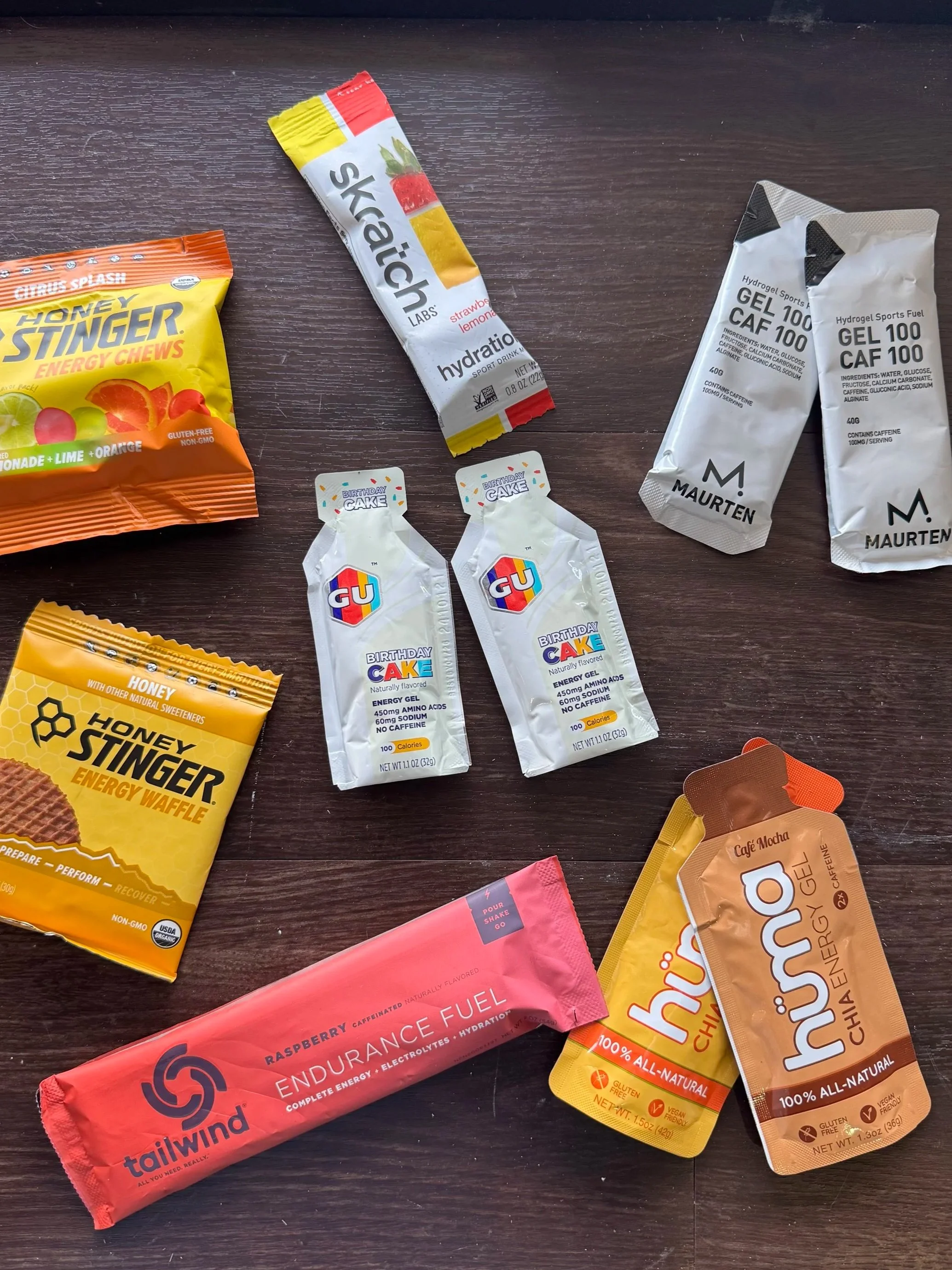Long Run Tips for Fall Marathon Training
Written by: Kim Kreuzman and Nicole Hamilton
Co-Owners and Lead Run Coaches of HAM Running, LLC
Why We Love the Long Run
For some, the flip of the calendar to September means pumpkin spice lattes, apple pies, hayrides, and crunchy leaves. But for runners, it signals something else: crisp air, cooler temps, and the payoff for all those humid summer miles chasing the sunrise and chasing goals.
It’s race season—and the long run is our weekly love letter to it.
The Long Run (LR, if you know you know) is the anchor of the week. It can be a date with a running buddy, a favorite podcast, or simply quiet time with the sound of your footfalls. It’s space to sort out your thoughts, reconnect with your body, and build steady confidence that carries to the start line.
So—how do you make the most of those miles? Let’s dive in.
1. Respect the Long Run
It’s not “just another run.” Rest well the night before, lay out your gear (shoes, socks, apparel, watch, hydration, nutrition, safety gear), and simplify your morning routine so all you have to do is get up and go. Make sure any electronics are charged and ready to go!
2. Pace with Patience
Fresh legs and excitement make it easy to start too fast - but that early surge can leave you fading later. Long runs are about endurance. A patient start lets your body warm up, find rhythm, and practice even or negative splits. This way, you finish strong instead of hanging on, and you build the kind of confidence that pays off on race day.
3. Love the Process
Big goals—like finishing your first marathon or chasing a PR—are exciting, but the real magic happens in the miles leading up to them. The long run is where you practice the craft of becoming a stronger, smarter runner. Every session teaches you something: how your body responds to fuel, how hydration impacts energy, how different shoes or apparel feel after 10+ miles, and how your mindset shifts when fatigue sets in.
Learning to embrace these lessons, even when they’re uncomfortable, builds resilience. You’re not just logging distance—you’re building problem-solving skills, testing race-day strategies, and strengthening mental toughness. When you view the long run as more than mileage—as a chance to learn and grow. Each LR moves you closer to your goal.
4. Fuel Like a Pro
Don’t just focus on shoes and watches—power your body, too.
Your gear may get you out the door, fuel is what carries you through the miles. As coaches we watch so many runners initially under-fuel their long runs, which can leave them depleted, struggling, or unable to finish strong. Think of fueling as part of your training—not just something you do on race day.
Night before: Think carb-focused dinner (yes, pasta party!).
Pre-run: Breakfast with carbs 1–2 hours ahead.
During: On a long run, Your body will burn through most of its available glucose. To stay energized, aim for 30–60g of carbs per hour (or more for some runners) That’s usually 1 gel/chew serving/other carb source serving every 30 minutes. Train your gut during long runs so you know what sits well—don’t gamble on race day.
Nutrition options at CRC
5. Hydrate & Electrolytes
Hydration is more than carrying a bottle—it’s a strategy. Start runs well-hydrated, and sip small amounts regularly instead of chugging. Runners need fluids during their run to stay hydrated, including electrolytes in their nutrition/hydration. This balance keeps energy steady, prevents cramps, and avoids that drained feeling late in the run. Practice your plan now so it’s second nature on race day.
When you sweat, you’re losing more than water—you’re losing sodium, potassium, magnesium, and chloride. Replacing these helps maintain muscle function and prevents that “dead leg” or dizzy feeling late in a run. Most sports drinks, electrolyte mixes, or salt tabs do the job—experiment to find what sits best with your stomach.
Check the Signs: Dark urine, headaches, and feeling sluggish can signal dehydration. Over-drinking plain water without electrolytes can also cause issues, so balance is key.
6. Mix It Up
Loops at a park help with pacing focus, while new routes keep things fresh. Use tools like Strava Routes for inspiration.
Running the same route week after week can make long runs feel like a chore. Mixing things up keeps training fresh, challenges your body in new ways, and builds mental toughness for race day.
Loops vs. Out-and-Backs: A park loop helps you focus on pacing without traffic or stoplights. Out-and-backs, on the other hand, test patience and discipline—especially when you’re tempted to turn around early. This technique is also great for managing nutrtion/hydration if you are able to “drop” supplies at a designated spot you are coming back every few miles to.
Route Scouting: Use tools like Strava Routes or MapMyRun to explore new neighborhoods, greenways, or city paths. Sometimes a new view is all you need to break up the monotony. Some watches even enable you to program your route onto it to avoid having concerns about staying on course.
Simulation Runs: Occasionally, design a route that mimics your goal race—similar elevation profile, aid station spacing, or even the time of day you’ll run. This builds both confidence and muscle memory.
8. Test Your Race Kit
“Nothing new on race day” is one of the golden rules of marathon training—and your long run is the perfect dress rehearsal. What feels fine for a 3-mile jog can become a nightmare over 18–20 miles if it chafes, slips, or causes blisters.
Test every layer—shorts, tops, sports bras, socks—and break in your race shoes. Practice with belts, vests, or handhelds fully loaded, and try gels or chews to see what sits well. Check your kit in different weather so race day is one less thing to worry about—you just run.
9. Find a Crew
Long miles feel shorter when shared. Running with a buddy or a small group adds accountability, motivation, and a sense of camaraderie that keeps spirits high when legs get heavy. (We call these (S)miles around here.)
Accountability: Knowing someone is waiting at the starting line—or along the route—makes it easier to get out the door, even on tough mornings.
Pacing Help: Running with others can help you maintain a steady pace, push gently when needed, and avoid starting too fast.
Mental Boost: Conversation, shared playlists, or just knowing you’re not alone keeps boredom and fatigue at bay.
Social & Safety Benefits: Running in a group can make new routes feel safer and more enjoyable. Plus, it’s a chance to build lasting friendships with people who share your goals.
10. Start Early
Even in fall, mornings can be warm. Running early helps you avoid heat, simulates race-day conditions, and gives you quiet, focused miles. It builds consistency, trains your body for morning energy levels, and lets you practice pacing, fueling, and routines in conditions similar to race day.
Bonus Track: Chunks, Not Mountains
Borrowed from endurance pro Heather Jackson: break your long run into manageable segments—like 2-mile or 10-minute chunks—so the distance feels bite-sized instead of overwhelming.
About the Coach: Coach Kim Kreuzman is a Road Runners Club of America Level 1 Certified Coach, experienced marketer, and social media manager who brings both creativity and strategy to the running world based in Charlotte, NC With over 20 years of competitive running experience—from the mile to ultramarathons—Kim has turned her passion for the sport into a lifelong pursuit of adventure, and community, and purpose.
She’s worked with athletes across all levels, from first-time runners to sub-elite marathoners, helping over 30 athletes set personal records and many qualify for World Majors for the first time.
Whether coaching athletes through their journey, pacing on race day, or cheering wildly behind the scenes Kim leads with empathy, enthusiasm, and belief in her athletes’ potential.
As a mother, wife, and small business owner, Kim understands the delicate balance of chasing big goals while managing real-life demands. Her coaching philosophy blends structure with flexibility—meeting athletes where they are and guiding them toward their goals with an understanding of how to balance big dreams and busy lives.



